February 22, 2010 – 5:40 am ET
The market displayed some impressive strength over the last week. We were looking for several key technical achievements to occur in order to indicate a return to the bullish trend. They were:
- New high from OBV on QQQQ
- Close by QQQQ above $44
- Close by SMH above its 90 day SMA
- OBV Bullish trend change on SMH
- OBV Bullish trend change on IWM
On Tuesday, the first day of the shortened trading week all of these milestones were achieved. Needless to say this is a very bullish sign.
.
ETF % Change Comparison
.

IYT, the Dow Transportation Index ETF was the top performer over the last week followed by IWM and SMH. Although none of the ETFs lagged behind significantly.
.
What the % Comparison Table Tells Us:
By comparing the performance of the economically sensitive (SMH, QQQQ, IWM, IYT) and the comparatively stable ETFs (SPY and DIA) we can get an indication of the true market direction. The more sensitive areas of the market tend to be the first to initiate a trend change. For example if DIA and SPY sell off heavily while SMH and IWM (Russell 2000 small cap ETF) sell of mildly or continue moving to new highs then this would be very positive and vice versa.
The ‘Average Rank %’ is calculated by subtracting the % change for each ETF from the maximum % change and dividing it by the range for each period. 1-((MAX(% change all ETFs)-ETFs % Change)/(MAX(% change all ETFs)-MIN(% change all ETFs))) The readings for each period are then averaged. This reading is provided because if one ETF was significantly under/out performing the others then a plain high or low rank would not accurately reflect this.
.
![]()
.
A Look at the Charts
.
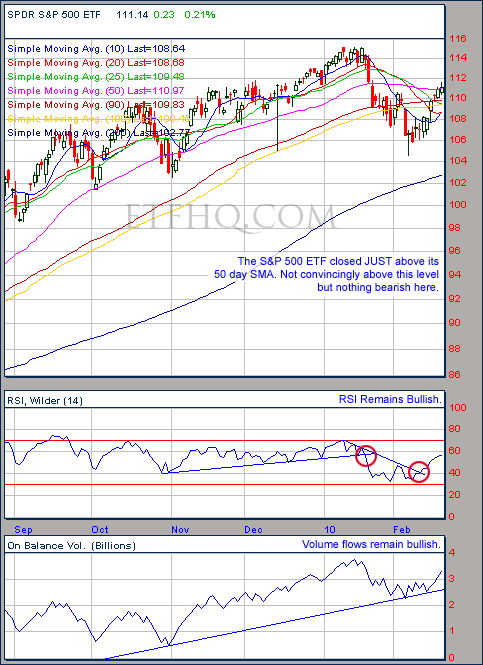
There is not much negative that can be said about SPY, with healthy volume flows, bullish RSI and an impressive recent advice. Although the 50 day SMA is yet to be convincingly surpassed and a test of support would not be surprising to see this coming week.
.
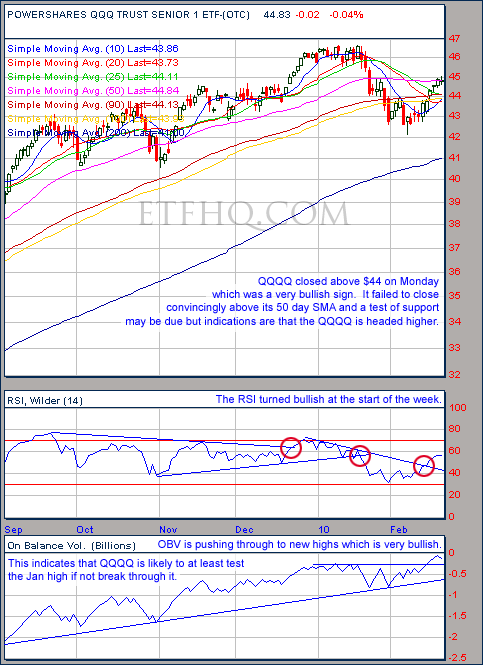
We were looking for a close above $44 and a new high from OBV and this occurred on Tuesday. With OBV pushing through to new highs it is likely that QQQQ is set to test the January high or hopefully break through it. The 50 day SMA remains an Achilles Heel and another reason why the market may be due for a breather and a test of support.
.
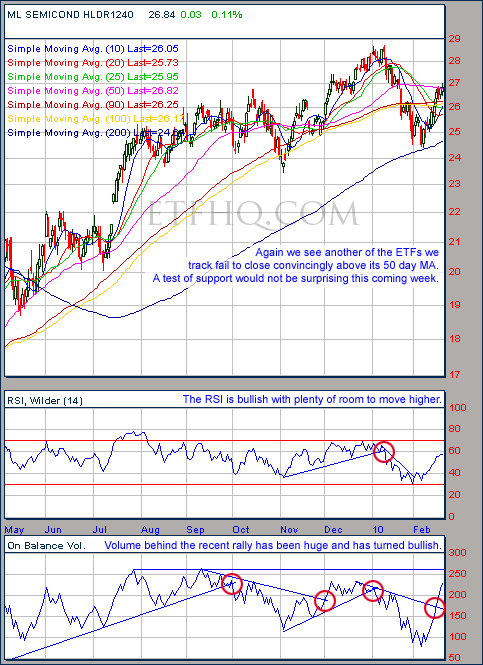
Volume flows on SMH powered ahead and are now in a bullish trend. There are cracks in the bullish argument however due to the under performance of volume flows until recently. A test of support will have to occur at some point and it will be interesting to see if that occurs before or after the 50 day SMA is broken.
Two weeks ago I said that in a rally I would expect AMAT to be the best performer out of SMH’s top three holdings. I certanly got this wrong; so far AMAT has been the worst performer of the three advancing just 2.21% while INTC is up 6.93% and TXN 8.88%.
.
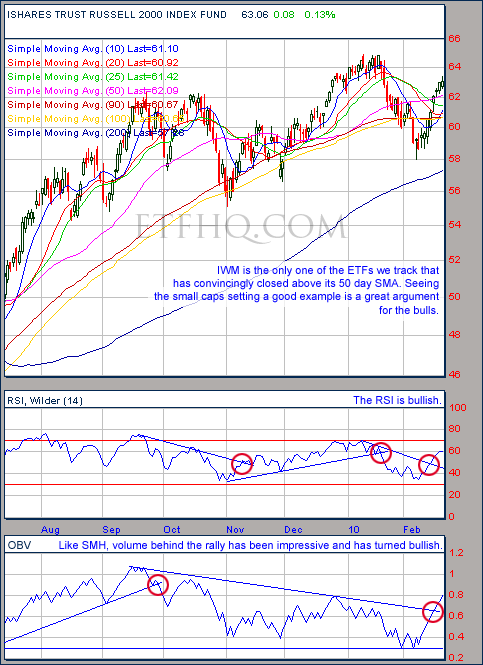
This is fantastic to see, IWM is the only one of the influential ETFs to really leave its 50 day SMA in the rear view mirror. Now IWM is only 2.76% away from the closing high it achieved 31 days ago. This strength from the Small Caps is a solid indication that the broad market will also be able to break through the 50 day SMA.
IWM, rather like SMH, has had under performing volume flows until recently. These are cracks in the bullish argument that should not be ignored.
.
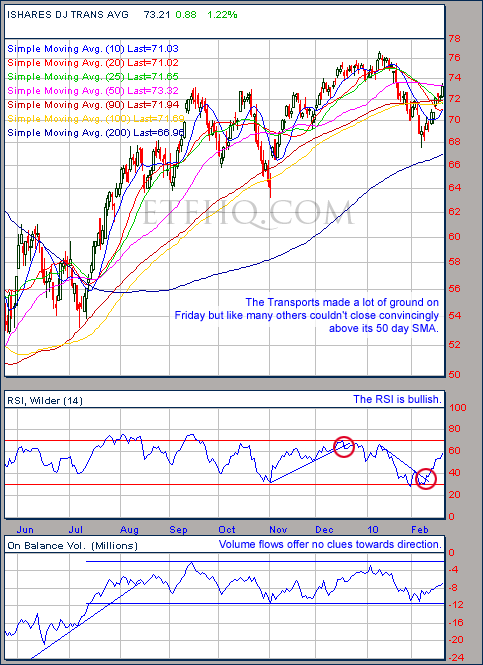
IYT powered ahead on Friday, no doubt to the cheers of the Dow theorists but again we see the 50 day SMA standing in the way. Volume indicates a continued trading range.
.
![]()
.
OM3 Weekly Indicator
.

The OM3 indicator has conflicting internal readings resulting in most of the ETFs receiving ‘No Signal’ while SMH and IWM are both on a ‘Strong Buy’. It is positive to see SMH and IWM exhibiting the most bullish readings however.
.
How to read the OM3 indicator
The OM3 indicator as with most of our models primarily reads price action and volume. The strong/weak buy/sell signals are self-explanatory. ‘No Signal’ means that the component readings are in conflict and cancel each other out.
The alerts let you know if the cycle is speeding up or slowing down, so when you get at ‘Strong Buy, Bear Alert’ for instance it simply means that the criteria for a strong buy is still in place but this weeks reading is weaker (or more bearish) than last weeks reading (the same is true in reverse).
The number of weeks that a signal has been repeated is displayed. Historically a ‘Strong Buy’ signal has lasted for an average of 6 weeks and a maximum of 42 weeks, while a ‘Strong Sell’ has lasted for an average of 4 weeks and a maximum of 16.
This is an indicator not a mechanical trading model. It is useful to assist in analyzing the market but for the best results should be combined with commonsense and support/resistance levels etc.
.
![]()
.
TransDow & NasDow
.

The Dow remains dominant over the Transportation Index and the NASDAQ. Historically little ground has been made by the broad market under these conditions and most of the disasters have occurred.
.
What the TransDow Readings tell us:
The TransDow measures dominance between the DJ Transportation Index (DJTI) and the Dow Jones Industrial Average (DJIA). In a strong market the more economically sensitive Transportation Index should be dominant over the DJIA.
Historically the DJTI has been dominant over the Dow 45% of the time. The annualized rate of return from the DJTI during this period was 18.47% with the biggest loss for one trade sitting at -13.27%. The annualized rate on the DJIA during the periods it was dominant over the DJTI was just 4.06% and the biggest loss for one trade was -16.13%. A 4% stop-loss is applied to all trades adjusting positions only at the end of the week.
What the NasDow Readings tell us:
The NasDow measures dominance between the NASDAQ and the DJIA. Using the same theory behind the Trans Dow; in a strong market the more economically NASDAQ should be dominant over the DJIA.
Historically the NASDAQ has been dominant over the DJIA 44% of the time. Taking only the trades when the NASDAQ is above its 40 week moving average the annualized rate of return was 25.47% with the biggest loss for one trade sitting at –8.59%. The annualized rate on the DJIA during the periods it was dominant over the NASDAQ is just 8.88% and the biggest loss for one trade was –12.28%. A 8% stop-loss is applied to all trades adjusting positions only at the end of the week.
.
![]()
.
LTMF 80 & Liquid Q
.
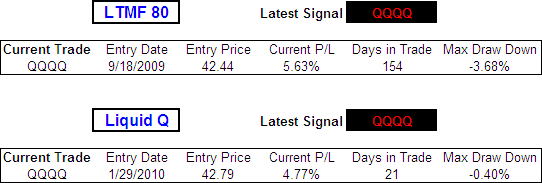
LTMF 80 and Liquid Q remain on buy signals and are both showing small profits for now. Their internal readings have strengthened significantly over the last week.
.
Historical Stats:
.

.
![]()
.
Summary
.
Indications are that we have returned to the bullish trend but a test of support will be due soon. IWM and SMH do however remind us of some cracks in the bullish argument, from a technical standpoint.
Semiconductor companies are extremely economically sensitive; they lead the business cycle and as a result tend to lead the market and reveal its true direction. In the Information Age semiconductors are like the railways of the Dow Theory during the Industrial Age. Likewise Small Caps are inherently more economically sensitive than Large Caps.
SMH was the first of the influential ETFs to peak 42 days ago while most of the others peaked 11 days later. Also from the beginning of September until just recently OBV has been significantly under performing the price action on both SMH and IWM. By OBV breaking below the November low earlier this month it indicated significant weakness and I was expecting a return to the bearish tend. However support held and now things are looking very good. This conflicting information points to the possibility that we are stuck in a trading range. For now however, the market is likely to have a bullish bias.
Any disputes, questions, queries… comments or theories are most welcome below.

.
Derry
And the Team @ ETF HQ
.
P.S If you get value from these newsletters please share the word with others. Thanks. If you are a new reader please subscribe using the form to the top right of this page.
P.P.S I hope this week leaves you feeling like Ivan Skobrev (left) did after seeing he had just posted the fastest time in the men’s 1,500m speed skating and not like Canada felt after losing to the US in the Hockey on home ice.
.
![]()
.
The Devils Dictionary – A
.
AAA – A credit rating which indicates a company has very little likelihood of default and therefore carries too little debt. By a process of financial alchemy, this rating now covers most of the riskiest corporate and consumer borrowers, which have too much debt. See Rating Agencies and CDO.
Accounting – An elaborate system of gibberish intended to describe the abstract theory of financial reality: how much money you have borrowed and can’t pay back (the balance sheet), how much money you are losing (the income statement) and how much worse this year is than last year (changes in financial condition); accounting has been integral to the history of civilization. Pacioli, a mathematician, published Summa de Arithmetica, Geometrica, Proportioni et Proportionalite in 1494, a year that closely coincided with Columbus’ discovery of America wherein the need to keep track of massive fraud, schemes, scams and other thievery was widely anticipated. An elegantly elaborate system of debits and credits known as ‘Double Entry Accounting’ quickly came to mean “two for me and none for you”. Without accounting there could be no fair system of taxation; this fact further highlights its failure because tax and fair remain like oil and water.
AICPA – The American Institute of Certified Public Accountants is the national, professional organization for all Certified Public Accountants. Its mission is to provide members with the resources, information, and leadership that enable them to provide valuable services in the highest professional manner to benefit the public as well as employers and clients. AICPA has a trademark lawsuit pending with the Absolutely Incurable Crooks and Perpetrators Association that it is expected to lose for imperceptibly different activities and mission.
AIG – The distressed vocalization of regulators upon examining the books and records of American International Group which was code for All Investments Gone; financial equivalent of “S.O.S – Mayday! Mayday!” While all the investments had gone to zero, incalculable liabilities remained as a result of an enormous unregulated gambling scheme known as Credit Default Swaps that left the U.S. Taxpayer holding a $200 billion bail-out bag that turned out to be heavier than a black hole.